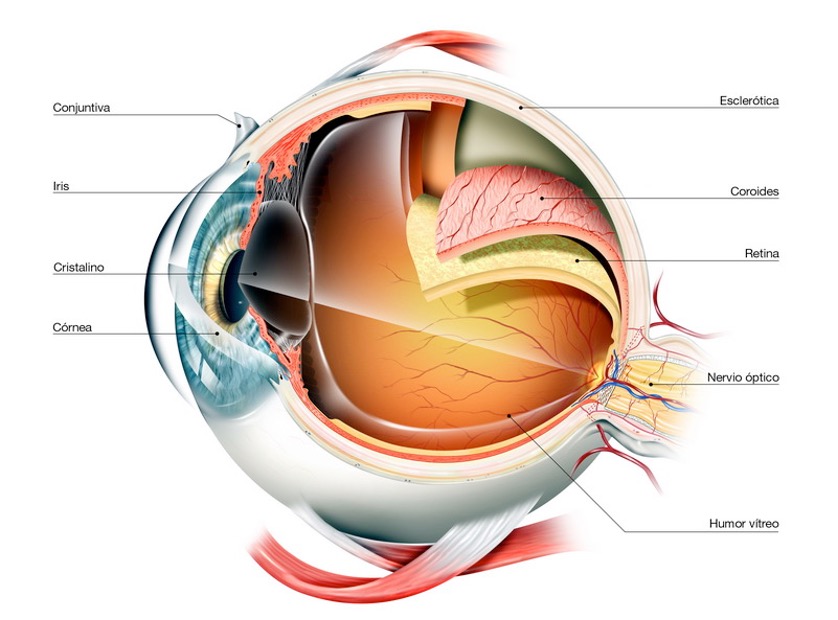Longer life expectancy means that diseases related to aging are on the rise. The visual system is not immune to this.
New more effective therapeutic strategies are needed to treat age-related eye diseases, and hydrogen sulfide appears to be one of them. Risk factors for these pathologies have been identified. Elevated homocysteine levels or oxidative stress mediated by hyperhomocysteinemia would be associated with vascular complications.
Dr. Celia Gonzalo Gleyzes – Neolife Medical Team
hyperhomocysteinemia (HHcy)
The sulfur-containing amino acid homocysteine is an intermediate product of methionine metabolism. Normally, there is a balance between the synthesis and the elimination of homocysteine, but sometimes a problem occurs and Hcy levels increase.
We’ve identified 4 pathways by which we may develop HHcy:
- Diet with excessive methionine intake
- Vitamin B12 and folate deficiency
- Hetero/homozygous activity of cystathionine-beta synthase
- Problems in renal clearance of Hcy
There are also other factors that may modulate the methionine cycle and increase homocysteine levels, such as age, gender, physical activity, alcohol consumption, smoking, and other individual comorbidities (other health problems).
Hyperhomocysteinemia (high blood homocysteine levels) induces an elevation of reactive oxygen species (ROS are oxygen ions, free radicals, and peroxides) and dysfunction of glutathione-related antioxidant defense, all leading to increased oxidative stress and decreased activity of antioxidant enzymatic activities.
Moderate homocysteine levels have been associated with atherosclerosis, myocardial infarction, carotid stenosis, venous thrombosis, and risk of stroke.
When it reaches high levels, it becomes a risk factor for ophthalmic vascular problems and other diseases of the visual system.

HHcy and age-related macular degeneration (AMD)
Age-related macular degeneration is one of the leading causes of blindness in people over 60 years of age. This disease causes damage to the peripheral retina, the choriocapillary layer, the retinal pigment epithelium (RPE) and Bruch’s membrane. There are several treatments available: photodynamic therapy, vascular endothelial growth factor (VEGF), and VEGF receptor inhibitors. The problem is that none of them is a definitive solution to the problem or prevents this pathology.
According to experimental studies in which homocysteine was injected into the vitreous, it has been concluded that it produces different alterations, including modifications of the RPE; it is considered an inflammatory factor for the eye. Homocysteine produces ROS that may activate matrix metalloproteinases (enzymes that break down proteins), damaging the vascular endothelium.
HHcy and diabetic retinopathy
Diabetic retinopathy is one of the complications of diabetes that affects even young people. It causes visual deficits and even blindness.
Diabetes involves the activation and expression of genes related to inflammation, altered homocysteine metabolism, and pyroptosis (inflammatory-type programmed cell death, dependent on the caspase-1 enzyme).
Laser treatment is frequently used, but there is a need to develop new therapies.
HHcy and glaucoma
This disease is more frequent in older patients and may be defined as neurodegenerative, characterized by a progressive loss of retinal ganglion cells. Risk factors include: race, age, family history, and high intraocular pressure. High blood pressure, diabetes mellitus, and vitamin B12 and folic acid deficiency are also elements to be taken into account.
Homocysteine induces changes in optic nerve microvascularization and alters optic nerve irrigation through different mechanisms: vasoconstrictor effect, smooth muscle cell proliferation, endothelial damage (inner vessel cells), thrombogenesis, platelet activation, and ganglion cell apoptosis.
HHcy and optic neuropathy
Non-arteritic anterior ischemic optic neuropathy (NAION) and retinal vascular occlusion are severe and fairly common pathologies that cause visual impairment.
High blood pressure, diabetes mellitus, smoking, high lipoprotein (a) level, and blood hyperviscosity contribute to these diseases. In turn, researchers relate homocysteine levels to these factors.
Hydrogen sulfide (H2S), a future treatment
Hydrogen sulfide is an endogenous gaseous transmitter (it is produced in our body, in the central nervous system, in the heart and in the blood).
There are four enzymatic pathways that regulate H2S production: cystathionine-beta-synthase (CBS), cystathionine gamma-lyase (CSE), CAT/3-mercaptopyruvate sulfurtransferase (CAT/3-MST), and D-amino acid oxidase (DAO/3MST). The first three have been detected in the retina.
In the central nervous system, H2S regulates synaptic activities as a neurotransmitter.
Some studies show that a deficit of CBS may lead to retinal degeneration and detachment.
H2S, by regulating calcium flux, may protect retinal neurons from light-induced degeneration, and would also have a vasodilatory effect on retinal arteries. (1)

How can I take care of my eyes and prevent future diseases?
- Modify your lifestyle: avoid the consumption of toxic substances (alcohol and smoking), maintain a balanced diet rich in polyphenols (and avoid overweight), keep stress under control (it increases cortisol levels and other hormones, risk of vasoconstriction…), and do sports.
- Take supplements (quality omega 3 like Neomega3, antioxidants like Neoenergy and NeoQ10 Ubiquinol, improve circulation with NeoGingko Pro, reduce homocysteine levels with Neovitamin plus etc)
- Start bioidentical hormone replacement therapy
- Perform genetic mapping if there is a familial tendency towards certain pathologies
- See your eye doctor. Even if you are asymptomatic, it is advisable to perform a fundus examination starting at 60.
- Get information on new treatments
BIBLIOGRAFÍA
(1) George AK, Homme RP, Stanisic D, Tyagi SC, Singh M. Protecting the aging eye with hydrogen sulfide. Can J Physiol Pharmacol. 2021 Feb;99(2):161-170. doi: 10.1139/cjpp-2020-0216. Epub 2020 Jul 28. PMID: 32721225
(2) https://pubmed.ncbi.nlm.nih.gov/32721225/

